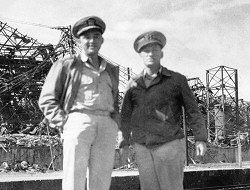Sharing Our StoriesWilliam F. Perdue
Nagasaki - 1945 (and Thirty Years Later) November 7, 1945 : The train began to slow as it neared its destination. Green fields and hills suddenly gave way to scenes of destruction never before imagined. My father, LT. Fred C Perdue, USN, gazed in awe at the ruins of Nagasaki, Japan. Three months earlier it had been a thriving port city of 195,000. At 11:02 a.m. Sunday morning, August 9th, “Fat Man” instantly changed Nagasaki into a wasteland. The world’s second (and so far, last) wartime nuclear explosion incinerated much of the city and thousands of its inhabitants. Little was left but smoldering rubble. Here and there, a smokestack, single wall or the broken metal skeleton of a building were all that remained standing. Over 45,000 people were killed instantly. Those near the center of the blast had simply been vaporized. Thousands of others would die later, suffering from the agony of radiation sickness. My father was the staff communications officer for an LST group. At sea not far from Hawaii, he had no idea what an atomic bomb was… but he was glad to hear of the attacks on Hiroshima and Nagasaki. News reached the amphibious fleet that the war was over when they were only days away from an invasion of main Japanese islands. Everyone welcomed the news with relief and joy. Like many others onboard, Dad survived D-Day and had provided continuous support to allied operations in Europe for nearly a year until the Nazis fell. Everyone knew an invasion of Japan would have extracted a heavy cost in American lives. Now that grim prospect had been eliminated. During the early days of the occupation, my father spent a lot of time near Wakayama, Japan seeing the sights: visiting shrines, gardens, and walking in the countryside. When the group commander planned to visit Nagasaki, Dad jumped at the chance to accompany him. It was a unique opportunity to see first hand what the atomic bomb had done to that industrial port city. Dad has said many times that they probably had no business making the trip to Nagasaki. It was probably not the safest of places to be. The Japanese could be seen peering cautiously around corners, regarding the small group of American naval officers with considerable suspicion. Now 89 years old, and 59 years removed, he hasn’t had much to say about his experience. He simply says there’s not much to talk about. He did mention the emptiness of the area… how several square miles had been totally wiped out. Steel frames of buildings were pushed away and flattened like a child’s toy that had been stepped on. While a limited amount of track had been restored to allow trains to get into the city, there were still large sections of rails that had been twisted, curled, and in some cases melted by the intense heat. The pictures he took speak volumes. I know he’s not sorry that we dropped the bombs. They helped end the war and saved countless lives. However, I can’t begin to imagine the impact that witnessing the overwhelming destruction created by that one blast must have had. pg. 2 |
|
|||||
